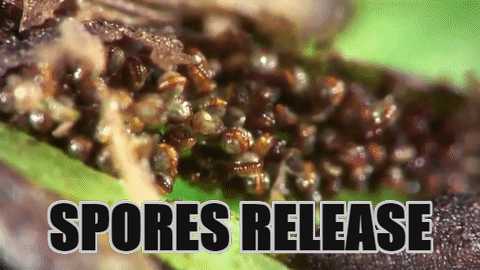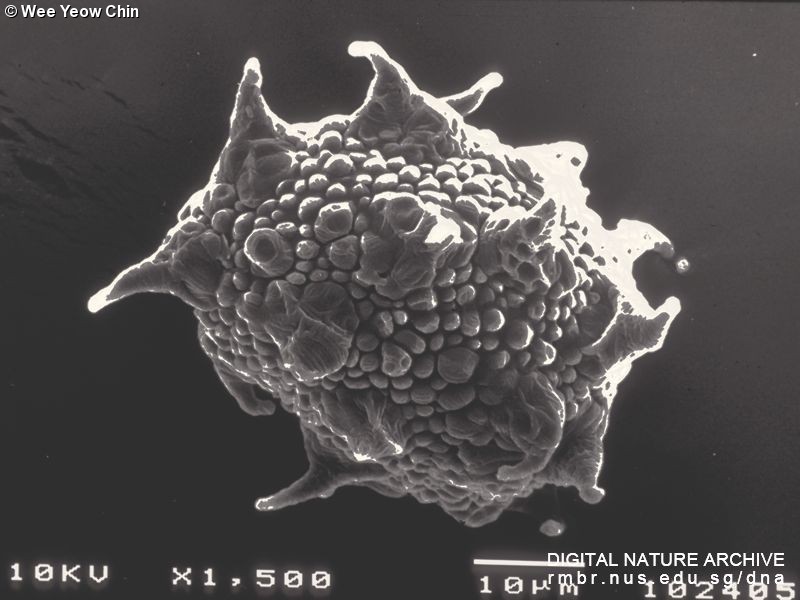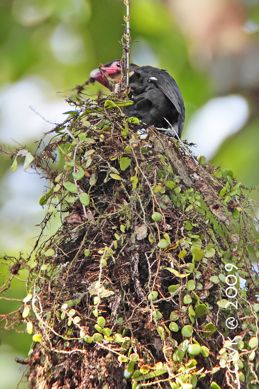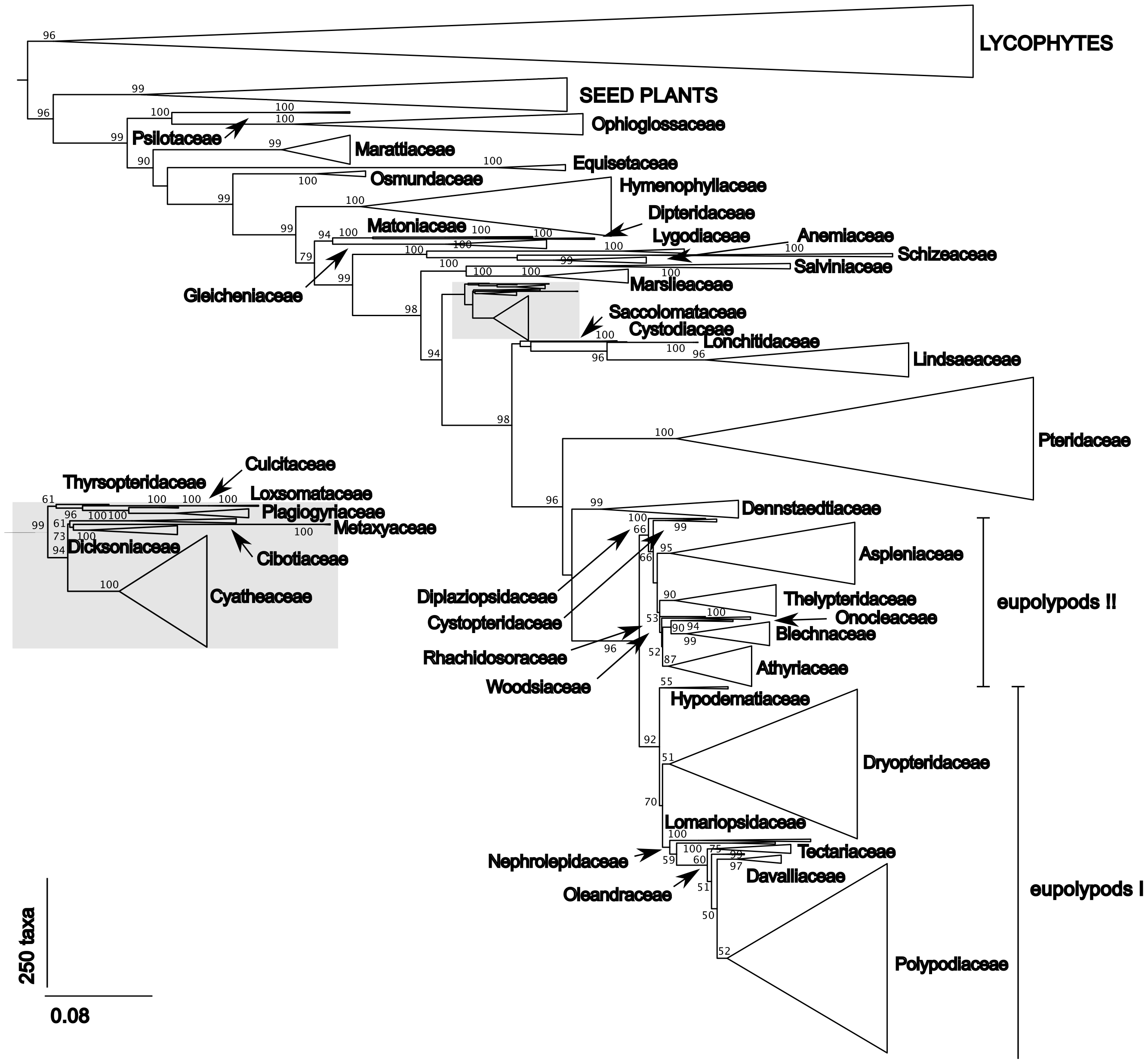Pyrrosia piloselloides (L.) M. Price
Dragon Scales/ Dragon's Scale FernTable of Contents
1. Introduction - Dragons in Singapore? Nope, just their scales!
If you walk along roads or parks of Singapore, you will definitely walk past the dragon's scales — the green scales that cover the old trees trunks. They are actually a fern species with scientific name, Pyrrosia piloselloides, and is one of the most common epiphytes in Singapore [1]. They can be seen at the roadside, parks, and forests. Basically, it's all over Singapore! For anyone who had curious mind on what these plants were while walking along the roads, this web page will be an opportunity for you to know more about the Dragon's scale fern. Dragon's scale fern is just as cool as its name!
  |
1.1 Name
1.1.1 Origin of the scientific name
Pyrrosia is a greek word meaning "fire-colored" which is named after the orange-colored spores [3] . Piloselloides means "hawkweed-like" which could be due to it resembling the long rhizomes of hawkweed.
1.1.2 Common names
Pyrrosia piloselloides has common English and Malay names like Dragon's scale fern, Dragon scales, Sakat Ribu-Ribu, and Sisek naga [2]. The local names also mean dragon scales when they are translated into English.
2. Where can it be found?
2.1 Singapore
Pyrrosia piloselloides are found in tropical, sub-tropical, or monsoonal climate areas [2]. Singapore is one of its native countries and it can be commonly seen on old tree trunks of Singapore. They can be found almost anywhere there are trees. You can find them along the road, parks, and forest as well.
2.2 Global
Global distribution of Pyrrosia piloselloides. Map created based on the data from Global Biodiversity Information Facility [4].
3. Identification
3.1 Morphology
Pyrrosia piloselloides has thin, long cable-like creeping rhizomes (roots). Its fronds (equivalent to leaves of other plants) are dimorphic. Fertile fronds are much longer in length ranging from 4 cm to 16cm with stipe (stalk) of about 1cm and distinct brown continuous sori (aggregated sporangia) along its margin of the lower surface. Sterile fronds are fleshy, oval in shape and with length ranging from 1cm to 7cm. Stipes which are also known as stalks are short or even absent in sterile fronds. All fronds are covered with white or brown stellate hairs [5].
3.2 Identification Key
Leaves large, bearing sporangia in clusters on their lower surface...leaves simple, generally with an entire undissected margin...Epiphytic, high-climbing or rock plants...Leaves covered below with white or brown stellate hairs...Sorus continuous, marginal [6].The key to identify Pyrossia sp. can be found here [7].
4. Biology
4.1 Life History
Life cycle of Fern. Video from Youtube by educreations
The life cycle of fern is divided into two phases: sporophytes and gametophytes. Pyrrosia piloselloides we find on the tree trunks are in their sporophyte phase. After meiosis, the unicellular spores which are in gametophyte stage are released. Spore of ferns is very light weighing less than 0.01mg [8]. When sporangia are dried, the spores are released and they can easily be dispersed by winds.


Fern spores gif (left). Video from Youtube by MartinMicroscope Microscopic photo of Pyrrosia piloselloides spore (right). Photo by Wee Yeow Chin (permission pending)
Once the heart-shaped prothallus as seen below matures, it will release sperm and egg and result in fertilization where the zygote formed will develop into sporophytes.

Heart-shaped prothallus with antheridia containing sperms. Photo by Wee Yeow Chin (permission pending)
4.2 Physiology - Crassulacean Acid metabolism(CAM) photosynthetic pathway
CAM Plants. Video from Youtube by Khan Academy
Species under Pyrrosia genus, including Pyrrosia piloselloides undergo CAM photosynthetic pathway which is found in many succulent plants that are adapted to desert environments (eg. cacti). At night, the plant stores carbon dioxide. During the day, it closes stomata and uses the stored carbon dioxide to carry out photosynthesis. CAM photosynthesis is seen as an adaptation by epiphytes. As the rhizomes of the epiphytes are exposed to the air, they are under constant threat of suffering drought stress. Through this photosynthetic pathway, the plants are able to reduce water loss during the day. Pyrrosia piloselloides was the first fern to be found to undergo CAM pathway in 1974 [9]. A study showed that Pyrrosia piloselloides is an obligate CAM plant which undergoes CAM pathway even when put under shady or humid environment. It had higher water use efficiency than other ferns undergoing C3 photosynthetic pathway [10].
5. Ecology

Photo of Dusky Broadbill decorating its nest using Pyrrosia piloselloides. Photo by CWK. (permission pending)
It is observed that Pyrrosia sp. tend to be the first colonizing epiphytes of a host tree which is also supported by the result from a study that it is common in urban areas which are more prone to disturbance[1,11].
Pyrrosia piloselloides has a commensal relationship with its host tree where Pyrrosia piloselloides benefits by having a rooting site without harming the host tree. However, too much growth could lead to smothering of host tree or create favorable conditions for fungal growth on the host tree[11]. Pyrrosia piloselloides have mutualistic relationships with other epiphytes as both epiphytes could provide each other with water and nutrient for their survival. Moreover, with its great abundance, birds use Pyrrosia piloselloides to camouflage with the surrounding environment. An example is Dusky Broadbill (Corydon sumatranus) which uses parts of Pyrrosia piloselloides to cover its nest to resemble the surrounding environment[12].
6. Medicinal Uses
Pyrrosia piloselloides is used as traditional folk medicine in different countries to treat different conditions. In Malaysia, extract of the plant is consumed to treat cough, diarrhea, and gonorrhea. The leaf extract is also used in the form of lotion to be applied for small pox, eczema, or skin rashes [2,13].
Studies have shown that Pyrrosia piloselloides can potentially be used to inhibit breast cancer and also be used as antioxidant as its extracts have shown cytotoxic activity[14]. It also showed antibacterial activities which could be potentially used as a treatment for Athlete's foot and other bacterial infections[15].
7. Taxonomy & Systematics
7.1 Original Description

Description of Pteris piloselloides on pg.1530 of Species Plantarum 2nd edition by Carl Linnaeus, 1762 - 63.
Basionym: Pteris piloselloides
Pyrrosia piloselloides was originally published in the book by Linnaeus in 1763 in another genus, Pteris [16]. The type specimen was not indicated in Species Plantarum by Carl Linnaeus.
Genus Drymoglossum was established by Presl in1836 to accommodate Pteris piloselloides. However, later it was found out that the differences in character states between Drymoglossum and Pyrrosia genus were not enough to justify the taxonomic recognition of a genus Drymoglossum separate from Pyrrosia [17]. (Pyrrosia genus is a sister to a monophyletic genus Platycerium [18].) The genus was then revised to present genus Pyrrosia by M. G. Price in Kalikasan 3: 176, 1974 [19].
7.2 Synonyms
Below is the list of synonyms of Pyrrosia piloselloides [19].
Drymoglossum piloselloides (L.) C. Presl
Drymoglossum piloselloides var. platycerioides Z. Teruya
Drymoglossum rotundifolium C. Presl
Elaphoglossum piloselloides (L.) Keyserl.
Lemmaphyllum piloselloides (L.) Luerss.
Notholaena piloselloides (L.) Kaulf. ex Kaulf.
Oetosis piloselloides (L.) Kuntze
Pteris piloselloides L.
Pteropsis piloselloides (L.) Desv.
Taenitis piloselloides (L.) R. Br
7.3 Classification
Taxonavigation is as follows [19]. Ranks were not included in the classification as they do not contain meaningful taxonomic information.
PlantaeFilicophytaPolypodiopsida Polypodiales Polypodiaceae Pyrrosia P. piloselloides |
8. Phylogeny
Figure1. The evolution of shoot development across land plants represented as a simple phylogenetic tree of extant land plants. Filled triangles represent monophyletic clades, whereas bryophytes clade is paraphyletic. Broader clades used for reference in this review are defined by the green bars above the phylogeny. The purple and blue lines represent the characters and their locations represent when such characters were evolved. Diagram by Plackett., et al (2015) [20].
The cladogram above shows a reconstructed evolutionary lineage of the extant land plants. Going down the lineage, the plants become more and more morphologically complex as it evolved from algae all the way down to flowering plants. Ferns are one of the important intermediate in the lineage which could possibly explain the evolutionary history of the plants. Monilophytes which includes fern has vascular tissues as one of the plesiomorphies (ancestral traits) while it developed lateral organs in fronds as an apomorphy (derived trait) in sporophyte shoots. Ferns are the closest sister group to seed plants and further study could find out how plants have evolved from seedless plants to seed plants.

Figure 2. The Maximum Likelihood tree showing the currently recognized fern families. Bootstrap support values greater than 50 are shown at nodes. The data set consisted of 2,957 taxa (rbcL 2,681; rps4 1,134; atpB 825; atpA 526 taxa) and 4,406 aligned base pairs of molecular data (rbcL 1,332; rps4 379; atpB1,188; atpA 1,507 bp). Creative Commons.[21]
In the maximum likelihood model, subfamilies of Polypodiaceae were monophyletic. Hence, it suggests that further study with greater data could be done to delimit Polypodioideae.[21]
Figure3. The strict consensus tree of the three most parsimonious trees recovered from maximum parsimony analyses of data set (98 polygrammoid fern taxa and three chloroplast DNA loci (rbcL genes, rps4 genes, and rps4-trnS intergenic spacer) combined) [22].
The bayesian value is 0.80 while the bootstrap value is 79. A Bootstrap value above 70 is as equivalent to having more than 95% of the clade being real. Hence, it can be safely deduced that the species is monophyletic [23]. (Bayesian values tend to overestimate its values. hence the value is not taken into account [24].) Based on the phylogenetic tree above, it is difficult to determine whether Pyrossia genus is monophyletic as not all Pyrrosia species were examined in this study. However, another study done on Pyrossia species showed that the genus is monophyletic [25]. This further supports the result above and that the Pyrrosia piloselloides is monophyletic.
8.1 DNA Barcode
Pyrrosia piloselloides ribosomal protein small subunit 4-like protein (rps4) gene, partial chloroplast sequence can be found here
Pyrrosia piloselloides ribulose-1,5-biphosphate carboxylase large subunit (rbcL) gene sequence can be found here
9. References
|